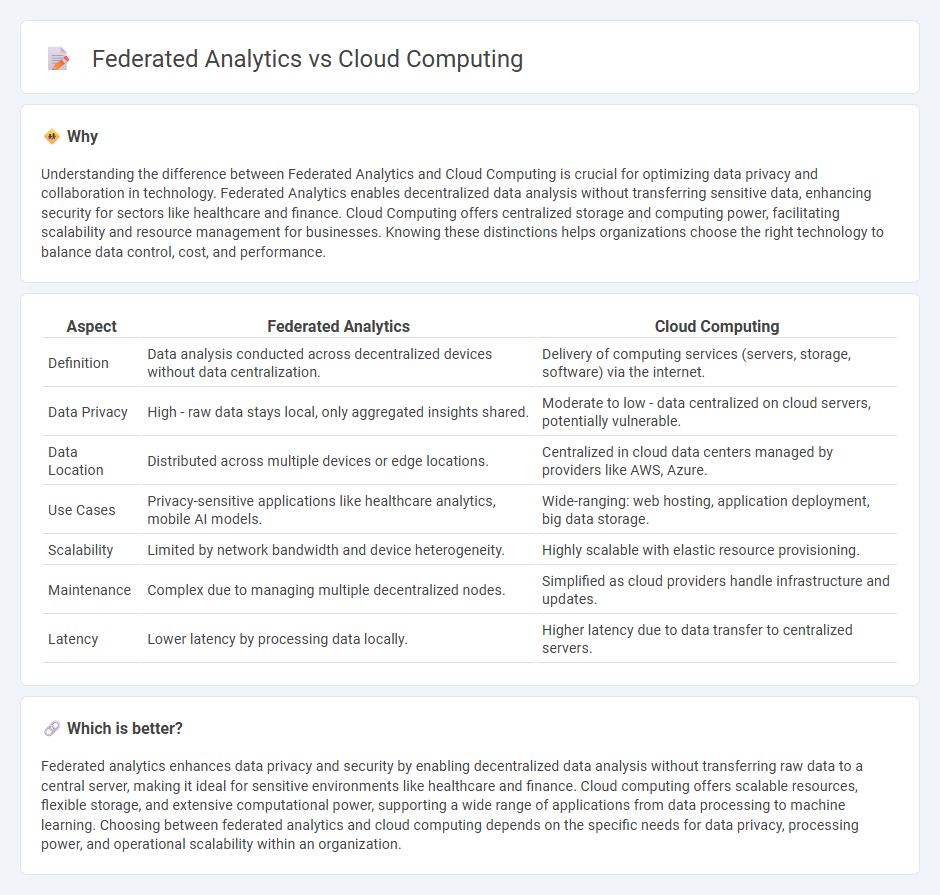
Federated analytics enables data analysis across decentralized sources without data centralization, enhancing privacy and compliance compared to cloud computing, which relies on centralized data storage and processing in remote servers. Cloud computing offers scalable resources and extensive service options but can raise concerns about data security and latency. Explore the advantages and challenges of each approach to determine the best fit for your technological needs.
Why it is important
Understanding the difference between Federated Analytics and Cloud Computing is crucial for optimizing data privacy and collaboration in technology. Federated Analytics enables decentralized data analysis without transferring sensitive data, enhancing security for sectors like healthcare and finance. Cloud Computing offers centralized storage and computing power, facilitating scalability and resource management for businesses. Knowing these distinctions helps organizations choose the right technology to balance data control, cost, and performance.
Comparison Table
| Aspect | Federated Analytics | Cloud Computing |
|---|---|---|
| Definition | Data analysis conducted across decentralized devices without data centralization. | Delivery of computing services (servers, storage, software) via the internet. |
| Data Privacy | High - raw data stays local, only aggregated insights shared. | Moderate to low - data centralized on cloud servers, potentially vulnerable. |
| Data Location | Distributed across multiple devices or edge locations. | Centralized in cloud data centers managed by providers like AWS, Azure. |
| Use Cases | Privacy-sensitive applications like healthcare analytics, mobile AI models. | Wide-ranging: web hosting, application deployment, big data storage. |
| Scalability | Limited by network bandwidth and device heterogeneity. | Highly scalable with elastic resource provisioning. |
| Maintenance | Complex due to managing multiple decentralized nodes. | Simplified as cloud providers handle infrastructure and updates. |
| Latency | Lower latency by processing data locally. | Higher latency due to data transfer to centralized servers. |
Which is better?
Federated analytics enhances data privacy and security by enabling decentralized data analysis without transferring raw data to a central server, making it ideal for sensitive environments like healthcare and finance. Cloud computing offers scalable resources, flexible storage, and extensive computational power, supporting a wide range of applications from data processing to machine learning. Choosing between federated analytics and cloud computing depends on the specific needs for data privacy, processing power, and operational scalability within an organization.
Connection
Federated analytics enables collaborative data analysis across decentralized sources while preserving data privacy, a process significantly enhanced by cloud computing's scalable infrastructure. Cloud computing provides the computational power and storage necessary to process Federated analytics workloads efficiently without transferring sensitive data to a central server. This synergy allows organizations to leverage large-scale analytics on distributed datasets, optimizing insights while maintaining strict compliance with data protection regulations.
Key Terms
Data Sovereignty
Cloud computing stores data in centralized servers often located across multiple countries, raising concerns about data sovereignty and cross-border data transfers. Federated analytics enables data processing at the source, ensuring that sensitive information remains within local jurisdictions and complies with regional data protection laws like GDPR. Explore how federated analytics can enhance your organization's data sovereignty while leveraging analytics capabilities.
Privacy-preserving Computation
Cloud computing enables centralized data processing with scalable resources but raises concerns about data privacy due to potential exposure during transmission and storage. Federated analytics offers a privacy-preserving computation framework by processing data locally on edge devices, sharing only aggregated insights to minimize data leakage risks. Explore how these approaches balance efficiency and privacy to enhance secure data analysis.
Source and External Links
What is Cloud Computing? Types, Examples and Benefits - Cloud computing delivers hosted IT services on-demand over the internet by renting computing resources like storage and applications from remote data centers managed by cloud providers, enabling scalable, flexible, and pay-as-you-go access to computing power and data analytics.
Cloud computing - Wikipedia - Cloud computing is a model that provides network access to a scalable pool of shared physical or virtual resources with key features such as on-demand self-service, broad network access, resource pooling, rapid elasticity, and measured service, as defined by standards like those from NIST and ISO.
What Is Cloud Computing? | IBM - Cloud computing means on-demand access over the internet to physical or virtual servers, storage, networking, software, and AI-powered tools, enabling greater flexibility, scalability, and cost efficiency compared to owning and managing traditional on-premises infrastructure.
 dowidth.com
dowidth.com